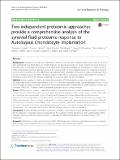Files in this item
Two independent proteomic approaches provide a comprehensive analysis of the synovial fluid proteome response to Autologous Chondrocyte Implantation
Item metadata
| dc.contributor.author | Hulme, Charlotte H. | |
| dc.contributor.author | Wilson, Emma L. | |
| dc.contributor.author | Fuller, Heidi R. | |
| dc.contributor.author | Roberts, Sally | |
| dc.contributor.author | Richardson, James B. | |
| dc.contributor.author | Gallacher, Pete | |
| dc.contributor.author | Peffers, Mandy J. | |
| dc.contributor.author | Shirran, Sally L. | |
| dc.contributor.author | Botting, Catherine H. | |
| dc.contributor.author | Wright, Karina T. | |
| dc.date.accessioned | 2018-05-03T11:30:11Z | |
| dc.date.available | 2018-05-03T11:30:11Z | |
| dc.date.issued | 2018-05-02 | |
| dc.identifier | 252995801 | |
| dc.identifier | 9a8a9986-d688-4848-9b27-27b98fc8d740 | |
| dc.identifier | 85046257550 | |
| dc.identifier | 000431295100011 | |
| dc.identifier.citation | Hulme , C H , Wilson , E L , Fuller , H R , Roberts , S , Richardson , J B , Gallacher , P , Peffers , M J , Shirran , S L , Botting , C H & Wright , K T 2018 , ' Two independent proteomic approaches provide a comprehensive analysis of the synovial fluid proteome response to Autologous Chondrocyte Implantation ' , Arthritis Research & Therapy , vol. 20 , 87 . https://doi.org/10.1186/s13075-018-1573-4 | en |
| dc.identifier.issn | 1478-6362 | |
| dc.identifier.other | RIS: urn:74D5C64CF4EA357F90780AEBBAAFF773 | |
| dc.identifier.other | RIS: Hulme2018 | |
| dc.identifier.other | ORCID: /0000-0003-3516-3507/work/44361957 | |
| dc.identifier.uri | https://hdl.handle.net/10023/13288 | |
| dc.description | We thank Arthritis Research UK for supporting this work via grants 19429, 20815 and 21122. MJP is supported through a Wellcome Trust Clinical Intermediate Fellowship. This work was supported by Wellcome Trust grant 094476/Z/10/Z, which funded the purchase of the TripleTOF 5600 mass spectrometer at the Biomedical Sciences Research Complex Mass Spectrometry and Proteomics Facility, University of St. Andrews (Fife, UK). | en |
| dc.description.abstract | Autologous chondrocyte implantation (ACI) has a failure rate of approximately 20%, but it is yet to be fully understood why. Biomarkers are needed that can pre-operatively predict in which patients it is likely to fail, so that alternative or individualised therapies can be offered. We previously used label-free quantitation (LF) with a dynamic range compression proteomic approach to assess the synovial fluid (SF) of ACI responders and non-responders. However, we were able to identify only a few differentially abundant proteins at baseline. In the present study, we built upon these previous findings by assessing higher-abundance proteins within this SF, providing a more global proteomic analysis on the basis of which more of the biology underlying ACI success or failure can be understood. | |
| dc.format.extent | 17 | |
| dc.format.extent | 1087692 | |
| dc.language.iso | eng | |
| dc.relation.ispartof | Arthritis Research & Therapy | en |
| dc.subject | Autologous chondrocyte implantation (ACI) | en |
| dc.subject | iTRAQ proteomics | en |
| dc.subject | Label-free quantitation proteomics | en |
| dc.subject | Synovial fluid | en |
| dc.subject | Cartilage repair | en |
| dc.subject | Complement C1S subcomponent | en |
| dc.subject | Matrix metalloproteinase 3 | en |
| dc.subject | MMP3 | en |
| dc.subject | R Medicine | en |
| dc.subject | QH301 Biology | en |
| dc.subject | DAS | en |
| dc.subject.lcc | R | en |
| dc.subject.lcc | QH301 | en |
| dc.title | Two independent proteomic approaches provide a comprehensive analysis of the synovial fluid proteome response to Autologous Chondrocyte Implantation | en |
| dc.type | Journal article | en |
| dc.contributor.sponsor | The Wellcome Trust | en |
| dc.contributor.institution | University of St Andrews. School of Biology | en |
| dc.contributor.institution | University of St Andrews. Biomedical Sciences Research Complex | en |
| dc.contributor.institution | University of St Andrews. School of Chemistry | en |
| dc.contributor.institution | University of St Andrews. EaSTCHEM | en |
| dc.identifier.doi | https://doi.org/10.1186/s13075-018-1573-4 | |
| dc.description.status | Peer reviewed | en |
| dc.identifier.grantnumber | 094476/Z/10/Z | en |
This item appears in the following Collection(s)
Items in the St Andrews Research Repository are protected by copyright, with all rights reserved, unless otherwise indicated.

